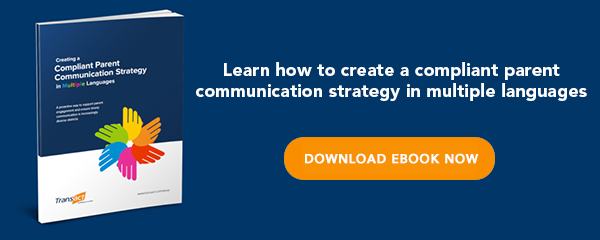The Every Student Succeeds Act (ESSA) went into effect at the beginning of the 2017-18 school year, forcing districts across the country to evaluate, re-write, and re-translate the parent and family notifications that are required under the law. During a webinar training about the required changes (recorded July 24, 2017), the question was raised, “Which letters do charter schools use to schedule a Parent and Family Engagement Policy development meeting, the ‘school’ level letter or the ‘district’ level letter?”
Determining if a charter school is only a school or if it also has the status of a school district sounds like a fairly simple question, but the answer is dependent on a number of somewhat complicated factors, three in particular:
- Is the charter school chartered by a local school district?
- Does the state treat charter schools like independent school districts?
- Is the charter school part of a charter school network that has the status of a school district?
The U.S. Department grants Title I funds to states, who in turn make subgrants of those Title I funds to school districts, who in turn distribute Title I funds to eligible schools in their district. ESSA requires that school districts that receive Title I funds through the state and the schools in those districts that receive Title I funds from the district develop a Parent and Family Engagement Policy. The district must have one at the district level and each school that receives Title I funds must have one at the school level.
If a charter school must apply to a local school district to become a charter school, then it is most likely considered part of that school district. In this case the charter school would use the school level letter “School Parent and Family Engagement Policy Meeting: Invitation to Participate”. One sure fire test is to find out if the charter school receives Title I funds from the local school district, or directly from the state. If Title I funding comes from the school district (or charter school network district), use the school level letter. If Title I funding comes directly from the state, then the school could use the district level letter (or the school level letter, read on).
Some states have laws or regulations that treat each charter school as an independent school district. In this situation the charter school must apply to the state for Title I funds and it would receive its Title I funds directly from the state (not through a local school district or charter network district). In this case, the charter school is a school district and could use the district level letter “District Parent and Family Engagement Policy Meeting: Invitation to Participate”. However, for charter schools that also have the status of a school district, one Parent and Family Engagement Policy would meet the compliance requirements at both the school and district level. So it would be permissible to use the school level letter “School Parent and Family Engagement Policy Meeting: Invitation to Participate” and not be out of compliance because the school policy would also serve as the district policy and vice versa. In fact, in this case it may make more sense to use the school level letter to invite parents and avoid the need to explain why you used a district letter to organize a meeting for a charter school.
Finally, in some cases you may find that the charter school is part of a network of charter schools. If the state treats that network of charter schools as an independent school district, then each school would be part of that school district and would not be considered an independent school district unto itself. In this case, the school should use the school level letter “School Parent and Family Engagement Policy Meeting: Invitation to Participate”. If the charter school is part of a charter school network, but is unsure about whether it is considered a district unto itself or a school in the “network” district, then it would be good to check with the network administrators to find out the charter school status as either a school or district. And again, a sure fire test is to find out if the charter school receives Title I funds from the charter school network district, or directly from the state. But regardless, a single charter school that is also considered a school district could use the school level letter because a single Parent and Family Engagement Policy would meet compliance requirements for both school and district purposes.
If you are still uncertain about the status of a charter school (district? or school?), then check with someone at your state’s department of education. For more information about charter schools click here.
For more information about TransACT’s Parent Notices and other products, please contact us at 425.977.2100, Option 3 or email at support@transact.com.




